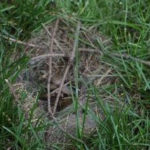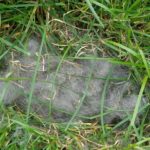BABY COTTONTAIL(S)
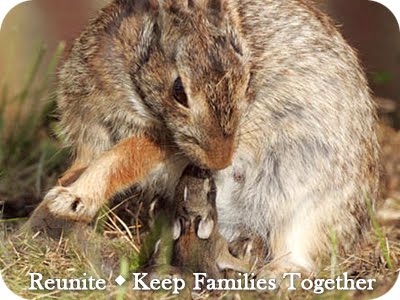
Staying with their biological parent is their best chance of survival.
1. OBSERVE
Where did you find the baby?
If an intact nest of baby rabbits is found, and the baby rabbits are not injured, leave them alone! Like deer, nursing mother rabbits only visit their young twice a day, at dawn and at dusk, to avoid attracting predators.
Finding baby rabbits alone in the nest is normal! Mother rabbits often make their nests in the middle of the lawn.
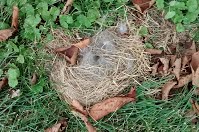
Before mowing your lawn:
Walk the yard first, carefully looking for any signs of a nest to avoid mowing over it.
Never relocate a rabbit nest. If a nest is moved, the disturbance is likely too great, and the mom will most often abandon her babies.
Never handle the babies. Mother rabbits are very sensitive to foreign smells and may abandon their young if handled.
How old is the baby?
If a baby rabbit the size of a furry tennis ball sits when approached, it is because the fight or flight response has not fully developed. Simply gently shoo the baby to an area that is more protected, such as under a bush, and leave the rabbit alone.
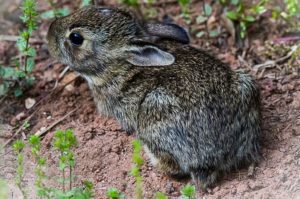
2. REUNITE
Was the nest disturbed?
If the rabbit nest appears to have been disturbed, or the baby rabbits appear to be orphaned, place a tic-tac-toe pattern of grass, wispy twigs, light string or yarn over the nest during the day, but before dusk, to assess whether the mother is returning to nurse them.
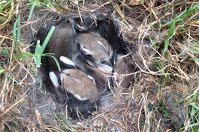
Did mom come back?
Take a photo of the tic-tac-toe pattern and return the next morning after sun up to see whether the tic-tac-toe pattern is displaced or pushed aside, with the nest still intact. If so, the mother returned to nurse her young. Leave the nest alone and keep all pets and people away.
Be sure to give the mother an entire day (until dark) to return to her young.
How quickly do they mature?
The baby rabbits will vacate the nest in 2-3 weeks. Finders should not touch the baby rabbits with bare hands. If it is necessary to pick up the baby rabbits to return them to the nest, use gloves. Mother rabbits are very sensitive to foreign smells and may abandon their young if handled. In addition, the young are very sensitive and can easily die when stressed by human beings or pets.
Death can occur hours after handling. Unfortunately, many rabbits succumb to capture myopathy (muscle damage resulting from extreme exertion, struggle, or stress), at the hands of well-intentioned human beings.
3. CALL
Call for help if:
During daylight the following day, the nest appearance has not changed since the tic-tac-toe was placed over the nest the day before.
The nest is disturbed, and the babies have their eyes closed, ears back and are strewn about.
One or more of the babies are injured or bleeding
The nest has been displaced or mother killed due to a gardening or mowing accident
One or more of the babies has been in a cat’s mouth
While you wait:
It is important to keep the baby rabbits warm and in a quiet, dark place. Place them in a small aerated container. Shoeboxes are great! To aerate the box, add pencil size holes poked from the inside towards the outside of the container.
Add a heat source (handwarmers, uncooked rice in a plastic bag heated in the microwave), placed inside an old sock so the heat source does not touch and burn tender skin. Wrap the babies inside a tee shirt or fleece and place the heat source next to them inside the box. A heating pad set to the low setting placed half way UNDER the outside of the shoebox can also be used to keep them warm.
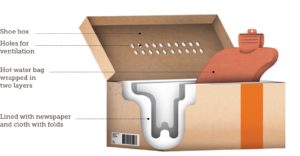
Place the bunnies in a quiet place away from pets, people, human noises (phone, music, etc.), and contact a wildlife rehabilitator for assistance.
Do NOT feed or handle the bunnies.
A cat’s saliva is deadly to wildlife:
This is especially true to baby rabbits. It is vital to keep cats and dogs away from the helpless young rabbits or they will be killed or mangled. If a cat or dog locates a nest, the pet must be removed and kept away from the nest. Cats and dogs will return to the nesting site once they know it exists.

